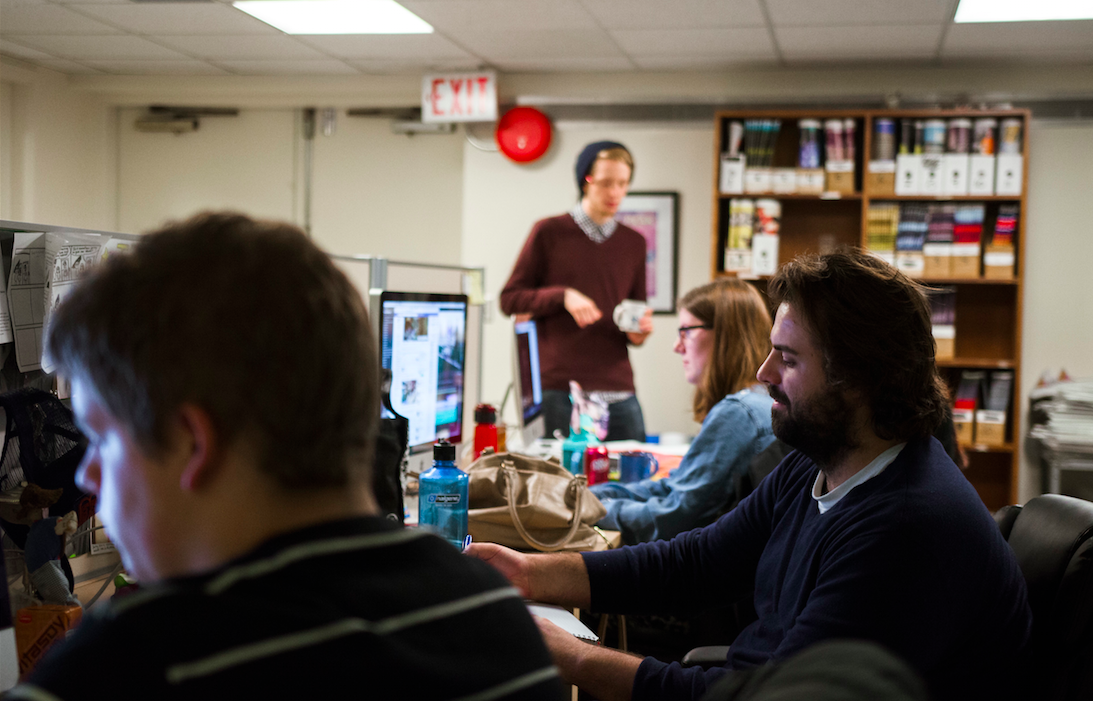Mohamed Sheriffdeen talks about his JHM-nominated story: his research, process and what it’s like to be nominated for your first news story.
[[{“fid”:”3753″,”view_mode”:”default”,”fields”:{“format”:”default”,”field_file_image_alt_text[und][0][value]”:””,”field_file_image_title_text[und][0][value]”:””},”type”:”media”,”link_text”:null,”attributes”:{“height”:”727″,”width”:”543″,”style”:”width: 200px; height: 268px; margin-left: 10px; margin-right: 10px; float: right;”,”class”:”media-element file-default”}}]]By Brennan Reid, Student Lounge Editor
Mohamed Sheriffdeen’s first news story turned out to be huge—a 2,500-word investigation about mould growing in Simon Fraser University’s Education Building. Written for The Peak, SFU’s independent student paper, “The Good, the Bad and the Mouldy” was Sheriffdeen’s first crack at a hard news story. It went on to become a cover story and was nominated for a John H. McDonald award.
Backstory
Although Sheriffdeen had written opinion pieces and editorials for the paper since 2012, when he started grad school, the environmental toxicology graduate student had no news reporting experience.
“News writing was very different than the writing I was used to,” said Sheriffdeen.
The idea for the story was Sheriffdeen’s—he had worked with people in the Teaching Support Staff Union (TSSU) and knew of the growing mould problem in their building. Staff over the years had reported health issues such as headaches, shortness of breath and nausea, symptoms that Sheriffdeen wrote were associated with mould exposure. He pitched it to his editor and was given the green light to write a short news story about the issue in May 2014.
Despite his lack of news reporting experience, Sheriffdeen was a natural fit for the story. “I had professional experience with mould,” thanks to his school work, he said. He also had contacts with faculty and students affected by the problem.
Opened in 1965, SFU has a lot of old buildings, many of which are falling into disrepair. To get an idea of the extent of the issue, Sheriffdeen followed the Twitter hashtag #IloveSFU and the Tumblr “I [heart] SFU.”
People were supposed to use the hashtag to show off the campus, said Sheriffdeen. “It got hijacked by people who wanted to point out that the SFU campus itself had some issues.”
Created in late 2011, the Tumblr was part of a competition that had students post photos of building maintenance issues in an effort to get the provincial government’s attention.
[node:related]
The Investigation
The story started to grow after Sheriffdeen found a key document: a building envelope assessment prepared for SFU by damage analysts. According to Sheriffdeen, the assessment had not been sent to the people most affected by the mould—the TSSU, on-campus unions or people who used the building every day.
This finding had obvious public interest and became the lede of the story.
Sheriffdeen originally got a copy of the report from John Bannister, a representative of the Canadian Union of Public Employees (CUPE) Local 3338, and forwarded it to the TSSU. The TSSU had requested a copy from the Environmental Health & Research Safety department, like Bannister had, but never received a copy.
Next came the challenges in reporting the story. When searching for sources, Sheriffdeen found many students and faculty who were willing to discuss their health concerns, the lack of transparency of the maintenance report and university administration. But getting them on the record was another matter.
“There were seven or eight people who I talked to who didn’t want to be quoted in the story,” said Sheriffdeen. Most of their reasons were easy to understand—faculty didn’t want to be seen speaking negatively about their employer.
“We were blessed because Mo had such a strong story on its own without having to rely on those additional anonymous sources,” said Max Hill, The Peak’s features editor at the time and current copy editor.
The big interview came when Terry Waterhouse, SFU’s chief safety officer, agreed to a sit-down interview. “He only agreed after we said we’d run the story anyway,” said Sheriffdeen. Waterhouse explained the report was one of several that would be collected into a final public document. He also explained how sending the report out to different organizations wasn’t a part of the process in place at the time—though, reports Sheriffdeen, it is now.
The story required heavy fact-checking, as well as knowledge of mould and its effects on human health. “I spent a week corroborating the information,” said Sheriffdeen.
Creation
Sheriffdeen had no assigned word count—his editor gave him free reign over the length of the piece. It took Sheriffdeen two weeks to write the first draft, and then it went into editing.
Sheriffdeen ended up cutting many quotes from sources. But the story relies heavily on named sources, with only one paragraph referencing “a number of long-time staffers.”
The Aftermath
As well as being nominated for the Canadian University Press’s JHM awards, the story spawned a follow-up the next school term, when mould was found in an SFU residence.
The story stirred up the SFU community, with many people coming forward to the TSSU with health and safety complaints. A grassroots movement to fix the growing maintenance issues gained momentum.
“I’m not going to take all the credit for what happened there,” said Sheriffdeen. “A lot of unions on campus took up the banner and ran with it.”
“We’re so used to it at SFU—like, oh yeah, mould, it’s totally a normal thing. But when you look at it from an outside perspective it’s like, the university is full of mould!” said Hill.
“I’m glad it had a positive outcome,” said Sheriffdeen, who now works as a research scientist in Toronto.
As for his experience at NASH?
“It was cool to be nominated.”

